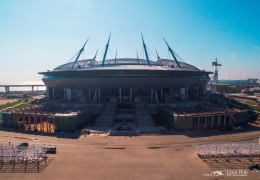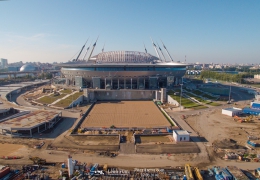Beginning of the 20-th century
By the beginning of the 20-th century Krestovsky Island was covered with swamps and forests. Most of its part was flooded even during a weak flooding, for this reason the stadium remained undeveloped for a long time. But it was already at that time when recreationists tended to spend time far from busy urban life – at one of the nearest green islands. After them the first sports clubs and cafes began to appear on Krestovsky Island, the government began to spend the first city’s festivals here.
Nikolsky stadium
In 1930-s a decision was made that Krestovsky Island would become a place for active amusement of citizens (decree of the joint plenum of Leningrad regional and urban committees (VKPb) dated December 15, 1934). The stadium for 100 000 spectators must have become a dominant of a new sports and entertainment centre of the city. Alexander Nikolsky, a famous architect, professor of the Arts Academy, honorary associate member of the Royal Institute of British Architects, was entrusted with design its design.
The stadium designed by Nikolsky must have been located on the western end of Krestovsky Island, have a hill shape and be made from soil, stone and reinforced concrete. Inner hill’s slopes formed a bowl for spectator’s bleachers. The external hill side represented an alternation of terraces and flat green slopes.
Construction began in 1934. Just for creating the ground level of the stadium 1 mln m3 of soil was required, another 2 mln m3 was spent on the construction of the hill itself. Apart from the stadium, the design must have included grounds for amateur sports, yacht club, sailing centre, aquatic theatre, beach, ski-jumps, high boards, floating fountains and outdoor swimming pools.
Post war
The Great Patriotic War made its adjustments. In 1941 construction of the stadium was stopped. Only after the end of military actions in 1945 it was resumed. It was a real national construction project which lasted for over 200 thousand hours. Students of construction institutes and vocational schools worked here, dozens of voluntary Sunday works were performed, in each of which from 3 to 7 thousand people took part.
The stadium was opened on July 30, 1950, where the match of two Leningrad teams – Zenit and Dynamo was held. Over 110 000 spectators gathered at the inauguration ceremony. 30 years later, on the eve of the 1980 Olympic Games the stadium was reconstructed. Afterwards reconstructions were repeated two more times: to the Goodwill Games (1994) and anniversary of St. Petersburg (2003).
New time
New time dictated new requirements for sports facilities: the stadium must have been not only big and national but also meet technical regulations of international federations, be able to provide additional services to visitors. To implement these tasks amidst the old stadium, where there were practically no rooms, did not appear to be possible.
In 2006 St. Petersburg Administration announced an architectural tender. Its winner became architect bureau Kisho Kurokawa Architects&Associates. The head of the bureau was already the author of several world-known stadiums in Japan, in particular, stadium in Toyota city, the prototype of which is considered by many as St. Petersburg project.
The old stadium was disassembled but pavilions adjacent to the hill, which became an integral part of the new project, were preserved. The idea of a space ship-saucer landed on the island formed the basis of the new stadium.
New stadium
Construction of the stadium based on the design of the Japanese bureau began in 2006. Initially works were performed by Avant company, soon the project customer – St. Petersburg Construction Committee terminated the contract with Avant and announced a new tender.
The winner of the new tender in 2008 was Transstroy company, which had implemented by this moment a large number of landmark projects, including, in the field of construction of new sports facilities and infrastructure facilities in St. Petersburg.
During the work constructors came across a number of difficulties related to design documentation amendment, including, due to Russia’s winning bid for the 2018 World Football Championship (St. Petersburg stadium will become the main ground for semifinal games) and the need to construct the stadium in accordance with the highest international regulations.
Major changes were related with many design aspects. For example, stadium sizes were changed: number of seat rose by over 20%. Layout solutions were also changed: additional various purpose rooms appeared, location and number of skyboxes were changed. Many key technical solutions were also reviewed, the main one of which – replacement of metal with concrete during the stadium bowl construction. The stadium with increased size must have a greater reliability.
In 2013 main design issue were solved and all conceptual design foundations laid by, Kisho Kurokawa were preserved. A retractable roof “soaring” on 8 pylons, roll-out field, entrances in the form of air ship portals and, of course, the “saucer” itself rising on the hill. One year before construction completion stadium readiness in May 2015 was over 75%.
Expected events
It is expected that general construction works on the stadium will be finished in May 2016, all construction works will be finished in December 2016 and full-scale inauguration will take place in 2017. By that moment the stadium which already received popular names Zenit Arena, Gazprom Arena and Piter Arena will have an official name.
Construction of the Western part of Krestovsky Island won’t be completed with this: by 2018 transport infrastructure of a new sport centre of the city must be formed here. In the close proximity to the arena a new metro station Novokrestovskaya will be opened here and a bridge, which will connect the island with Primorskiy district, will be built. Construction of a yacht club is also planned near the stadium, creation of walking and recreation zones and many others.

















